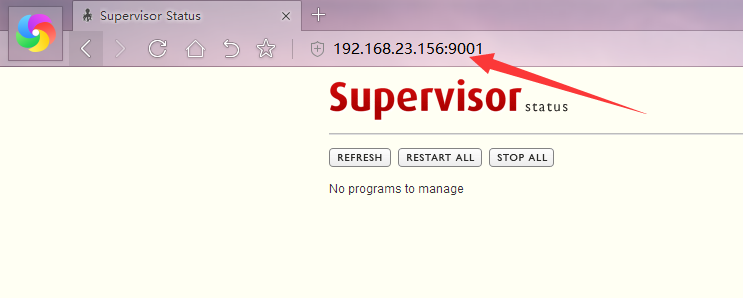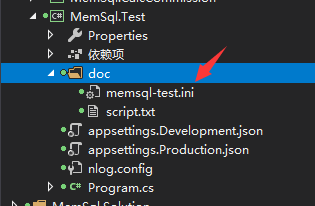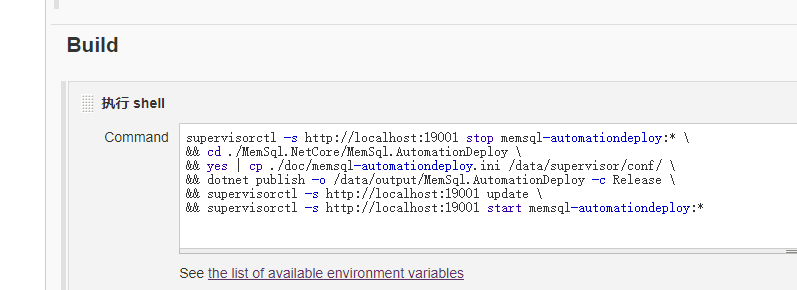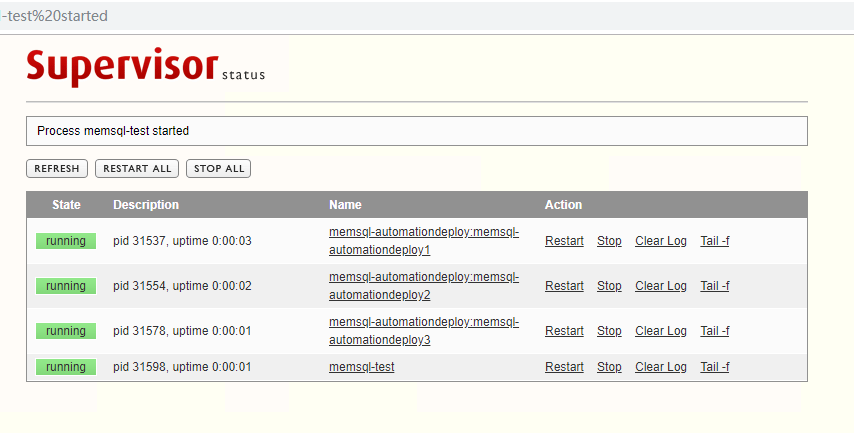上一篇我们用jenkins做了一个简单的自动化发布,在shell中采用的是 BUILD_ID=dontKillMe nohup dotnet xxx.dll & 这种简单的后台承载,如果你的业务
量相对比较小,可以用这个方法玩一玩,但存在二个问题:1. 无法对进程进行批量或者可视化管理。 2. 单机模式下的多副本部署比较麻烦,比如你在一台机
器上开启多个同样的程序来提高队列的处理能力,解决这两个问题你可以使用netcore官方推荐的supervisor 进程管理工具。
一: supervisor
具体这玩意是干嘛的,我就不说了,大家自己看官网: http://www.supervisord.org/ 接下来快速部署一下。
1. pip
pip是python的一个包管理器,类似于nuget,如果你的centos上没有安装,那么请执行下面命令。
1 yum -y install epel-release 2 yum -y install python-pip
2. supervisor
因为supervisor是python写的,所以直接通过pip进行安装即可。
1 [root@k8s-node1 ~]# pip install supervisor 2 Collecting supervisor 3 Downloading https://files.pythonhosted.org/packages/ba/65/92575a8757ed576beaee59251f64a3287bde82bdc03964b89df9e1d29e1b/supervisor-3.3.5.tar.gz (421kB) 4 100% |████████████████████████████████| 430kB 47kB/s 5 Collecting meld3>=0.6.5 (from supervisor) 6 Downloading https://files.pythonhosted.org/packages/b6/ae/e6d731e4b9661642c1b20591d8054855bb5b8281cbfa18f561c2edd783f7/meld3-1.0.2-py2.py3-none-any.whl 7 Installing collected packages: meld3, supervisor 8 Running setup.py install for supervisor ... done 9 Successfully installed meld3-1.0.2 supervisor-3.3.5 10 You are using pip version 10.0.1, however version 18.1 is available. 11 You should consider upgrading via the 'pip install --upgrade pip' command. 12 [root@k8s-node1 ~]# pip install --upgrade pip 13 Collecting pip 14 Downloading https://files.pythonhosted.org/packages/c2/d7/90f34cb0d83a6c5631cf71dfe64cc1054598c843a92b400e55675cc2ac37/pip-18.1-py2.py3-none-any.whl (1.3MB) 15 100% |████████████████████████████████| 1.3MB 49kB/s 16 Installing collected packages: pip 17 Found existing installation: pip 10.0.1 18 Uninstalling pip-10.0.1: 19 Successfully uninstalled pip-10.0.1 20 Successfully installed pip-18.1
3. supervisord
这个就是supervisor的server端,启动之前生成一个默认的配置文件,放在 /data/supervisor/目录下。
1 [root@k8s-node1 supervisor]# pwd 2 /data/supervisor 3 [root@k8s-node1 supervisor]# echo_supervisord_conf > ./supervisord.conf 4 [root@k8s-node1 supervisor]# ls 5 supervisord.conf
关于配置文件的详细配置,你可以参考官方的:http://www.supervisord.org/configuration.html ,

; Sample supervisor config file. ; ; For more information on the config file, please see: ; http://supervisord.org/configuration.html ; ; Notes: ; - Shell expansion ("~" or "$HOME") is not supported. Environment ; variables can be expanded using this syntax: "%(ENV_HOME)s". ; - Quotes around values are not supported, except in the case of ; the environment= options as shown below. ; - Comments must have a leading space: "a=b ;comment" not "a=b;comment". ; - Command will be truncated if it looks like a config file comment, e.g. ; "command=bash -c 'foo ; bar'" will truncate to "command=bash -c 'foo ". [unix_http_server] file=/tmp/supervisor.sock ; the path to the socket file ;chmod=0700 ; socket file mode (default 0700) ;chown=nobody:nogroup ; socket file uid:gid owner ;username=user ; default is no username (open server) ;password=123 ; default is no password (open server) ;[inet_http_server] ; inet (TCP) server disabled by default ;port=127.0.0.1:9001 ; ip_address:port specifier, *:port for all iface ;username=user ; default is no username (open server) ;password=123 ; default is no password (open server) [supervisord] logfile=/tmp/supervisord.log ; main log file; default $CWD/supervisord.log logfile_maxbytes=50MB ; max main logfile bytes b4 rotation; default 50MB logfile_backups=10 ; # of main logfile backups; 0 means none, default 10 loglevel=info ; log level; default info; others: debug,warn,trace pidfile=/tmp/supervisord.pid ; supervisord pidfile; default supervisord.pid nodaemon=false ; start in foreground if true; default false minfds=1024 ; min. avail startup file descriptors; default 1024 minprocs=200 ; min. avail process descriptors;default 200 ;umask=022 ; process file creation umask; default 022 ;user=chrism ; default is current user, required if root ;identifier=supervisor ; supervisord identifier, default is 'supervisor' ;directory=/tmp ; default is not to cd during start ;nocleanup=true ; don't clean up tempfiles at start; default false ;childlogdir=/tmp ; 'AUTO' child log dir, default $TEMP ;environment=KEY="value" ; key value pairs to add to environment ;strip_ansi=false ; strip ansi escape codes in logs; def. false ; The rpcinterface:supervisor section must remain in the config file for ; RPC (supervisorctl/web interface) to work. Additional interfaces may be ; added by defining them in separate [rpcinterface:x] sections. [rpcinterface:supervisor] supervisor.rpcinterface_factory = supervisor.rpcinterface:make_main_rpcinterface ; The supervisorctl section configures how supervisorctl will connect to ; supervisord. configure it match the settings in either the unix_http_server ; or inet_http_server section. [supervisorctl] serverurl=unix:///tmp/supervisor.sock ; use a unix:// URL for a unix socket ;serverurl=http://127.0.0.1:9001 ; use an http:// url to specify an inet socket ;username=chris ; should be same as in [*_http_server] if set ;password=123 ; should be same as in [*_http_server] if set ;prompt=mysupervisor ; cmd line prompt (default "supervisor") ;history_file=~/.sc_history ; use readline history if available ; The sample program section below shows all possible program subsection values. ; Create one or more 'real' program: sections to be able to control them under ; supervisor. ;[program:theprogramname] ;command=/bin/cat ; the program (relative uses PATH, can take args) ;process_name=%(program_name)s ; process_name expr (default %(program_name)s) ;numprocs=1 ; number of processes copies to start (def 1) ;directory=/tmp ; directory to cwd to before exec (def no cwd) ;umask=022 ; umask for process (default None) ;priority=999 ; the relative start priority (default 999) ;autostart=true ; start at supervisord start (default: true) ;startsecs=1 ; # of secs prog must stay up to be running (def. 1) ;startretries=3 ; max # of serial start failures when starting (default 3) ;autorestart=unexpected ; when to restart if exited after running (def: unexpected) ;exitcodes=0,2 ; 'expected' exit codes used with autorestart (default 0,2) ;stopsignal=QUIT ; signal used to kill process (default TERM) ;stopwaitsecs=10 ; max num secs to wait b4 SIGKILL (default 10) ;stopasgroup=false ; send stop signal to the UNIX process group (default false) ;killasgroup=false ; SIGKILL the UNIX process group (def false) ;user=chrism ; setuid to this UNIX account to run the program ;redirect_stderr=true ; redirect proc stderr to stdout (default false) ;stdout_logfile=/a/path ; stdout log path, NONE for none; default AUTO ;stdout_logfile_maxbytes=1MB ; max # logfile bytes b4 rotation (default 50MB) ;stdout_logfile_backups=10 ; # of stdout logfile backups (0 means none, default 10) ;stdout_capture_maxbytes=1MB ; number of bytes in 'capturemode' (default 0) ;stdout_events_enabled=false ; emit events on stdout writes (default false) ;stderr_logfile=/a/path ; stderr log path, NONE for none; default AUTO ;stderr_logfile_maxbytes=1MB ; max # logfile bytes b4 rotation (default 50MB) ;stderr_logfile_backups=10 ; # of stderr logfile backups (0 means none, default 10) ;stderr_capture_maxbytes=1MB ; number of bytes in 'capturemode' (default 0) ;stderr_events_enabled=false ; emit events on stderr writes (default false) ;environment=A="1",B="2" ; process environment additions (def no adds) ;serverurl=AUTO ; override serverurl computation (childutils) ; The sample eventlistener section below shows all possible eventlistener ; subsection values. Create one or more 'real' eventlistener: sections to be ; able to handle event notifications sent by supervisord. ;[eventlistener:theeventlistenername] ;command=/bin/eventlistener ; the program (relative uses PATH, can take args) ;process_name=%(program_name)s ; process_name expr (default %(program_name)s) ;numprocs=1 ; number of processes copies to start (def 1) ;events=EVENT ; event notif. types to subscribe to (req'd) ;buffer_size=10 ; event buffer queue size (default 10) ;directory=/tmp ; directory to cwd to before exec (def no cwd) ;umask=022 ; umask for process (default None) ;priority=-1 ; the relative start priority (default -1) ;autostart=true ; start at supervisord start (default: true) ;startsecs=1 ; # of secs prog must stay up to be running (def. 1) ;startretries=3 ; max # of serial start failures when starting (default 3) ;autorestart=unexpected ; autorestart if exited after running (def: unexpected) ;exitcodes=0,2 ; 'expected' exit codes used with autorestart (default 0,2) ;stopsignal=QUIT ; signal used to kill process (default TERM) ;stopwaitsecs=10 ; max num secs to wait b4 SIGKILL (default 10) ;stopasgroup=false ; send stop signal to the UNIX process group (default false) ;killasgroup=false ; SIGKILL the UNIX process group (def false) ;user=chrism ; setuid to this UNIX account to run the program ;redirect_stderr=false ; redirect_stderr=true is not allowed for eventlisteners ;stdout_logfile=/a/path ; stdout log path, NONE for none; default AUTO ;stdout_logfile_maxbytes=1MB ; max # logfile bytes b4 rotation (default 50MB) ;stdout_logfile_backups=10 ; # of stdout logfile backups (0 means none, default 10) ;stdout_events_enabled=false ; emit events on stdout writes (default false) ;stderr_logfile=/a/path ; stderr log path, NONE for none; default AUTO ;stderr_logfile_maxbytes=1MB ; max # logfile bytes b4 rotation (default 50MB) ;stderr_logfile_backups=10 ; # of stderr logfile backups (0 means none, default 10) ;stderr_events_enabled=false ; emit events on stderr writes (default false) ;environment=A="1",B="2" ; process environment additions ;serverurl=AUTO ; override serverurl computation (childutils) ; The sample group section below shows all possible group values. Create one ; or more 'real' group: sections to create "heterogeneous" process groups. ;[group:thegroupname] ;programs=progname1,progname2 ; each refers to 'x' in [program:x] definitions ;priority=999 ; the relative start priority (default 999) ; The [include] section can just contain the "files" setting. This ; setting can list multiple files (separated by whitespace or ; newlines). It can also contain wildcards. The filenames are ; interpreted as relative to this file. Included files *cannot* ; include files themselves. ;[include] ;files = relative/directory/*.ini
上面的文件主要改两个地方:
《1》 开启supervisor的可视化界面
;[inet_http_server] ; inet (TCP) server disabled by default ;port=127.0.0.1:9001 ; ip_address:port specifier, *:port for all iface ;username=user ; default is no username (open server) ;password=123 ; default is no password (open server)
改成:
[inet_http_server] ; inet (TCP) server disabled by default port=0.0.0.0:9001 ; ip_address:port specifier, *:port for all iface ;username=user ; default is no username (open server) ;password=123 ; default is no password (open server)
《2》 下面这个语法表示可以加载指定目录的所有ini文件,这个口子就方便我们给每个应用程序配一个xx.ini文件,这样当你update的时候,supervisor会
自动 将conf目录下*.ini文件和supervisor.conf进行合并。
;[include] ;files = relative/directory/*.ini
改成
[include] files = ./conf/*.ini
最后启动一下,更多的你可以通过help命令查看。
[root@k8s-node1 supervisor]# supervisord -c ./supervisord.conf

4. supervisorctl
supervisotctl 是一个客户端工具,通过9001端口与server进行交互,可处理如下18个命令。
[root@k8s-master supervisord]# supervisorctl help default commands (type help <topic>): ===================================== add exit open reload restart start tail avail fg pid remove shutdown status update clear maintail quit reread signal stop version
接下来可以在conf目录下生成一个 consoleapp3.ini 文件,程序名为:consoleapp3。
[root@k8s-master conf]# tail consoleapp3.ini [program:consoleapp3] command=/usr/bin/dotnet /data/supervisord/ConsoleApp3/ConsoleApp3.dll autostart=true autorestart=true stdout_logfile=/data/supervisord/ConsoleApp3/1.log
执行以下update命令让supervisor重新加载配置文件。
[root@k8s-master supervisord]# supervisorctl update

回到文章开头的问题,如果生成多个副本,你可以采用group模式,比如下面这样的 mytest.ini 文件放置到conf目录下。
[group:mytest] programs=mytest1,mytest2,mytest3 [program:mytest1] command=/usr/bin/dotnet /data/supervisord/mytest/ConsoleApp1.dll autostart=true autorestart=true stdout_logfile=/data/supervisord/mytest/4.log [program:mytest2] command=/usr/bin/dotnet /data/supervisord/mytest/ConsoleApp1.dll autostart=true autorestart=true stdout_logfile=/data/supervisord/mytest/5.log [program:mytest3] command=/usr/bin/dotnet /data/supervisord/mytest/ConsoleApp1.dll autostart=true autorestart=true stdout_logfile=/data/supervisord/mytest/6.log
然后通过 supervisorctl update 让supervisor重新加载配置文件,然后可观察可视化界面。
[root@k8s-master conf]# supervisorctl update
mytest: added process group

有了这个基础之后,和jenkins集成就很简单了,因为9001端口被占用,就重新指定了一个19001端口,把应用程序的*.ini文件放在解决方案里,这样自动化的
时候就可以找到*.ini文件,然后copy到supervisor的conf目录下,因为是强制copy,所以用管道模式 yes | .....

《1》 普通模式
supervisorctl -s http://localhost:19001 stop memsql-test && cd ./MemSql.NetCore/MemSql.Test && yes | cp ./doc/memsql-test.ini /data/supervisor/conf/ && dotnet publish -o /data/output/MemSql.Test -c Release && supervisorctl -s http://localhost:19001 update && supervisorctl -s http://localhost:19001 start memsql-test
《2》 组模式
supervisorctl -s http://localhost:19001 stop memsql-automationdeploy:* && cd ./MemSql.NetCore/MemSql.AutomationDeploy && yes | cp ./doc/memsql-automationdeploy.ini /data/supervisor/conf/ && dotnet publish -o /data/output/MemSql.AutomationDeploy -c Release && supervisorctl -s http://localhost:19001 update && supervisorctl -s http://localhost:19001 start memsql-automationdeploy:*


好了,本篇就说到这里,如果有人问多机器怎么玩,下篇再说ansible~
